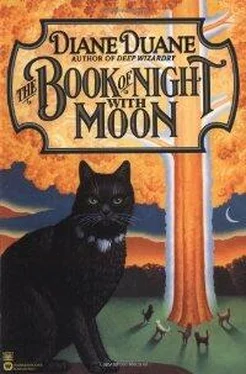Diane Duane - The Book of Night with Moon
Здесь есть возможность читать онлайн «Diane Duane - The Book of Night with Moon» весь текст электронной книги совершенно бесплатно (целиком полную версию без сокращений). В некоторых случаях можно слушать аудио, скачать через торрент в формате fb2 и присутствует краткое содержание. Год выпуска: 1997, ISBN: 1997, Издательство: Hodder & Stoughton, Жанр: Фэнтези, на английском языке. Описание произведения, (предисловие) а так же отзывы посетителей доступны на портале библиотеки ЛибКат.
- Название:The Book of Night with Moon
- Автор:
- Издательство:Hodder & Stoughton
- Жанр:
- Год:1997
- ISBN:0-340-69328-2
- Рейтинг книги:5 / 5. Голосов: 1
-
Избранное:Добавить в избранное
- Отзывы:
-
Ваша оценка:
- 100
- 1
- 2
- 3
- 4
- 5
The Book of Night with Moon: краткое содержание, описание и аннотация
Предлагаем к чтению аннотацию, описание, краткое содержание или предисловие (зависит от того, что написал сам автор книги «The Book of Night with Moon»). Если вы не нашли необходимую информацию о книге — напишите в комментариях, мы постараемся отыскать её.
The Book of Night with Moon — читать онлайн бесплатно полную книгу (весь текст) целиком
Ниже представлен текст книги, разбитый по страницам. Система сохранения места последней прочитанной страницы, позволяет с удобством читать онлайн бесплатно книгу «The Book of Night with Moon», без необходимости каждый раз заново искать на чём Вы остановились. Поставьте закладку, и сможете в любой момент перейти на страницу, на которой закончили чтение.
Интервал:
Закладка:
The Book of Night with Moon
by Diane Duane
I am the Cat who took up His stance by the Persea Tree, on the night we destroyed the enemies of God…
Pert em hru, c. 2800 b.c., tr. BudgeBite: bite hard, and find the tenth life.
—The Gaze of Rhoua’s Eye (feline recension of The Book of Night with Moon): Ixiii, 18For Keith De Candido
A Note on Feline Linguistics
Ailurin is not a spoken language, or not simply spoken. Like all the human languages, it has a physical component, the cat version of “body language,” and a surprising amount of information is passed through the physical component before a need for vocalized words arises.
Even people who haven’t studied cats closely will recognize certain “words” in Ailurin: the rub against a friendly leg, the arched back and fluffed fur of a frightened cat, the crouch and stare of the hunter. All of these have strictly physical antecedents and uses, but they are also used by cats for straight forward communication of mood or intent. Many subtler signs can be seen by even a human student: the sideways flirt of the tail that says “I don’t care” or “I wonder if I can get away with this…” the elaborate yawn in another cat’s face, the stiff-legged, arch-backed bounce, which is the cat equivalent of making a face and jumping out at someone, shouting “Boo!” But where gestures run out, words are used—more involved than the growl of threat of purr of contentment, which are all most humans hear of intercat communication.
“Meowing” is not counted here, since cats rarely seem to meow at each other. That type of vocalization is usually a “pidgin” language used for getting humans’ attention: the cat equivalent of “Just talk to them clearly and loudly and they’ll get what you mean sooner or later.” Between each other, cats sub-vocalize using the same mechanism that operates what some authorities call “the purr box,” a physiological mechanism that is not well understood but seems to have something to do with the combined vibration of air in the feline larynx and blood in the veins and arteries of the throat. To someone with a powerful microphone, a cat speaking Ailurin seems to be making very soft meowing and purring sounds ranging up and down several octaves, all at a volume normally inaudible to humans.
This vocalized part of Ailurin is a “pitched” language, like Mandarin Chinese, more sung than spoken. It is mostly vowel-based—no surprise in a species that cannot pronounce most human-style consonants. Very few noncats have ever mastered it: not only does any human trying to speak it sound to a cat as if he were shouting every word, but the delicate intonations are filled with traps for the unwary or unpracticed. Auo hwaai hhioehhu uaeiiiaou, for example, may look straightforward: “I would like a drink of milk” is the Cat-Human Phrasebook definition. But the people writing the phrasebook for the human ear are laboring under a terrible handicap, trying to transliterate from a thirty-seven-vowel system to an alphabet with only five. A human misplacing or mispronouncing only one of the vowels in this phrase will find cats smiling gently at him and asking him why he wants to feed the litter-box to the taxicab? … this being only one of numerous nonsenses that can be made of the above example.
So communication from our side of things tends to fall back on body language (stroking, or throwing things, both of which cats understand perfectly well) and a certain amount of monologue—which human-partnered cats, with some resignation, accept as part of the deal. For their communications with most human beings, the cats, like so many of us, tend to fall back on shouting. For this book’s purposes, though, all cat-to-human speech, whether physical or vocal, is rendered as normal dialogue: that’s the way it seems to the cats, after all. [1] Cat thoughts and silent communications are rendered in italics.
One other note: two human-language terms, “queen” and “tom,” are routinely used to translate the Ailurin words sh’heih and sth’heih. “ Female” and “male” don’t properly translate these words, being much too sexually neutral—which cats, in their dealings with one another, emphatically are not. The Ailurin word ffeih is used for both neutered males and spayed females.
—DD
Chapter One
They never turn the lights off in Grand Central; and they may lock the doors between 1 and 5:30 a.m., but the place never quite becomes still. If you stand outside those brass-and-glass doors on Forty-second Street and peer in, down the ramp leading into the Grand Concourse, you can see the station’s quiet nightlife—a couple of transit police officers strolling past, easygoing but alert; someone from the night cleaning crew heading toward the information island in the center of the floor with a bucket and a lot of polishing cloths for all that century-old brass. Faintly, the sound of rumblings under the ground will come to you—the Metro-North trains being moved through the upper- and lower-level loops, repositioned for their starts in the morning, or tucked over by the far-side tracks to be checked by the night maintenance crews. On the hour, the massive deep gong of the giant Accurist clock facing Forty-second strikes, and the echoes chase themselves around under the great blue sky-vault and slowly fade.
By five o’clock the previous day’s dust will have been laid, the locks checked, the glass on the stores in the Graybar and Hyatt passageways all cleaned: everything done, until it’s time to open again. The transit policemen, still in a pair because after all this is New York and you just can’t tell, will stroll past, heading up the stairs on the Vanderbilt Avenue side to sit down in the ticketed passenger waiting area and have their lunch break before the day officially starts. Anyone looking in through the still-locked Forty-second Street doors will see nothing but stillness, the shine of slick stone and bright brass.
But there are those for whom locked doors are no barrier. Were you one of them, this morning, you would slip sideways and through, padding gently down the incline toward the terrazzo flooring of the concourse. The place would smell green, the peculiar too-strong wintergreen smell of a commercial sweeping compound. Your nose would wrinkle as you passed a spot on the left, against the cream-colored wall, where blood was spilled yesterday—a disagreement, a knife and a gun pulled, everything finished in a matter of seconds: one life wounded, one life fled, the bodies taken away. But the disinfectants and the sweeping compound can’t hide the truth from you and the stone.
You would walk on, pause in the center of the room, and look upward, as many tunes before, at the starry, painted vault of the heavens—its dusk-blue rather faded, and half the bulbs in the Zodiac’s constellations burnt out. The Zodiac is backward. They’ll be renovating the ceiling this spring, but you doubt they’ll fix that problem. It doesn’t matter, anyway: after all, “backward” depends on which direction you’re looking from…
You would walk on again then, guided by senses other than the purely physical ones, and stroll silently over to the right of the motionless up-escalators, toward the gate to Track 25. Once through its archway, everything changes. The ambiance of the terminal—light, air, openness— abruptly shifts: the ceiling lowers, the darkness closes in. Lighting comes in the form of long lines of fluorescent fixtures, only one out of every three of them lit, this time of day. They shine down in bright dashed lines on the seven platforms to your right, the nine to your left, and straight ahead, on the gray concrete of the platform that serves Tracks 25 and 26. Behind you, a pool of warm light lies under the windows of the glass-walled room that is the Trainmaster’s Office. Little light, though, makes it past the platform’s edge to the tracks themselves. They are long trenches of shadow between pale gray plateaus of concrete that stretch, tapering, into the middle distance, vanishing into more darkness. The rails themselves gleam faintly only close to where you stand: they too reach off into the dark, converging, and swiftly disappear. Red and green track guidelights shine dully there. A few shine brighter: the track crew members are down there, walking the rails to check for obstructions and wiping the lights off as they come.
Читать дальшеИнтервал:
Закладка:
Похожие книги на «The Book of Night with Moon»
Представляем Вашему вниманию похожие книги на «The Book of Night with Moon» списком для выбора. Мы отобрали схожую по названию и смыслу литературу в надежде предоставить читателям больше вариантов отыскать новые, интересные, ещё непрочитанные произведения.
Обсуждение, отзывы о книге «The Book of Night with Moon» и просто собственные мнения читателей. Оставьте ваши комментарии, напишите, что Вы думаете о произведении, его смысле или главных героях. Укажите что конкретно понравилось, а что нет, и почему Вы так считаете.












